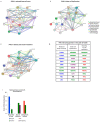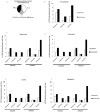p-21 Activated Kinase as a Molecular Target for Chemoprevention in Diabetes
- PMID: 31011108
- PMCID: PMC6371191
- DOI: 10.3390/geriatrics3040073
p-21 Activated Kinase as a Molecular Target for Chemoprevention in Diabetes
Abstract
Anti-diabetic drugs modulate p-21 activated kinase (PAK) signaling. Introduction: Type 2 diabetes mellitus (T2DM) is a chronic inflammatory disease associated with increased cancer risk. PAK signaling is implicated in cellular homeostasis when regulated, and cancer when unrestrained. Recent reports provided a role for PAK signaling in glucose homeostasis, but the role of PAKs in the pathogenesis of T2DM is unknown. Here, we performed a mini-meta-analysis to explore if anti-diabetic drugs modify PAK signaling pathways, and provide insight regarding modulation of these pathways, to potentially reduce diabetes-associated cancer risk. Methods: PAK interacting partners in T2DM were identified using the online STRING database. Correlation studies were performed via systematic literature review to understand the effect of anti-diabetic drugs on PAK signaling. A mini-meta-analysis correlated multiple clinical studies and revealed the overall clinical response rate and percentage of adverse events in piogliazone (n = 53) and metformin (n = 91) treated patients with PAK-associated diseases. Results: A total of 30 PAK interacting partners were identified (10: reduced beta-cell mass; 10: beta-cell dysfunction; 10: obesity-insulin resistance), which were highly associated with Wnt, and G-protein signaling. The anti-diabetic drug metformin activated signaling pathways upstream; whereas pioglitazone inhibited pathways downstream of PAK. Overall, clinical response upon pioglitazone treatment was 53%. Seventy-nine percent of pioglitazone and 75% of metformin treated patients had adverse events. Pioglitazone reduced molecular-PAK biomarkers of proliferation (Ki67 and CyclinD1), and metformin had the opposite effect. Conclusions: PAK signaling in T2DM likely involves Wnt and G-protein signaling, which may be altered by the anti-diabetic drugs metformin and pioglitazone. Apart from the therapeutic limitations of adverse events, pioglitazone may be promising in chemoprevention. However long-term multi-centered studies, which initiate pioglitazone treatment early will be required to fully assess the full potential of these drugs.
Keywords: cancer; chemoprevention; inflammation; metformin; p-21 activated kinase; pioglitazone; type 2 diabetes mellitus.
Conflict of interest statement
The authors declare no conflicts of interest.
Figures





Similar articles
-
Anti oxidant potential of Metformin and Pioglitazone in Type 2 Diabetes Mellitus: Beyond their anti glycemic effect.Diabetes Metab Syndr. 2016 Apr-Jun;10(2):102-4. doi: 10.1016/j.dsx.2015.08.016. Epub 2015 Aug 24. Diabetes Metab Syndr. 2016. PMID: 26341927 Clinical Trial.
-
Inflammatory cytokines and chemokines, skeletal muscle and polycystic ovary syndrome: effects of pioglitazone and metformin treatment.Metabolism. 2013 Nov;62(11):1587-96. doi: 10.1016/j.metabol.2013.07.004. Epub 2013 Aug 17. Metabolism. 2013. PMID: 23958241 Clinical Trial.
-
Targeting the pathophysiology of type 2 diabetes: rationale for combination therapy with pioglitazone and exenatide.Curr Med Res Opin. 2008 Nov;24(11):3009-22. doi: 10.1185/03007990802390795. Epub 2008 Oct 2. Curr Med Res Opin. 2008. PMID: 18828960 Review.
-
High Glucose with Insulin Induces Cell Cycle Progression and Activation of Oncogenic Signaling of Bladder Epithelial Cells Cotreated with Metformin and Pioglitazone.J Diabetes Res. 2019 Jan 9;2019:2376512. doi: 10.1155/2019/2376512. eCollection 2019. J Diabetes Res. 2019. PMID: 30729133 Free PMC article.
-
Repositioning of diabetes treatments for depressive symptoms: A systematic review and meta-analysis of clinical trials.Psychoneuroendocrinology. 2018 Aug;94:91-103. doi: 10.1016/j.psyneuen.2018.05.010. Epub 2018 May 7. Psychoneuroendocrinology. 2018. PMID: 29775878
Cited by
-
Metformin Prevents Tumor Cell Growth and Invasion of Human Hormone Receptor-Positive Breast Cancer (HR+ BC) Cells via FOXA1 Inhibition.Int J Mol Sci. 2024 Jul 8;25(13):7494. doi: 10.3390/ijms25137494. Int J Mol Sci. 2024. PMID: 39000600 Free PMC article.
-
p21-Activated Kinase 1 (Pak1) as an Element in Functional and Dysfunctional Interplay Among the Myocardium, Adipose Tissue, and Pancreatic Beta Cells.Compr Physiol. 2025 Apr;15(2):e70006. doi: 10.1002/cph4.70006. Compr Physiol. 2025. PMID: 40065530 Free PMC article. Review.
-
Cdc42/Rac Interactive Binding Containing Effector Proteins in Unicellular Protozoans With Reference to Human Host: Locks of the Rho Signaling.Front Genet. 2022 Feb 2;13:781885. doi: 10.3389/fgene.2022.781885. eCollection 2022. Front Genet. 2022. PMID: 35186026 Free PMC article. Review.
-
The Role of p21-Activated Kinases in Cancer and Beyond: Where Are We Heading?Front Cell Dev Biol. 2021 Mar 16;9:641381. doi: 10.3389/fcell.2021.641381. eCollection 2021. Front Cell Dev Biol. 2021. PMID: 33796531 Free PMC article. Review.
-
miR-4417 suppresses keloid fibrosis growth by inhibiting CyclinD1.J Biosci. 2020;45:47. J Biosci. 2020. PMID: 32345773
References
-
- Szklarczyk D., Franceschini A., Wyder S., Forslund K., Heller D., Huerta-Cepas J., Simonovic M., Roth A., Santos A., Tsafou K.P., et al. STRING v10: Protein-protein interaction networks, integrated over the tree of life. Nucleic Acids Res. 2015;43:D447–D452. doi: 10.1093/nar/gku1003. - DOI - PMC - PubMed
-
- Campregher C., Schmid G., Ferk F., Knasmuller S., Khare V., Kortum B., Dammann K., Lang M., Scharl T., Spittler A., et al. MSH3-deficiency initiates EMAST without oncogenic transformation of human colon epithelial cells. PLoS ONE. 2012;7:e50541. doi: 10.1371/journal.pone.0050541. - DOI - PMC - PubMed
Publication types
LinkOut - more resources
Full Text Sources

